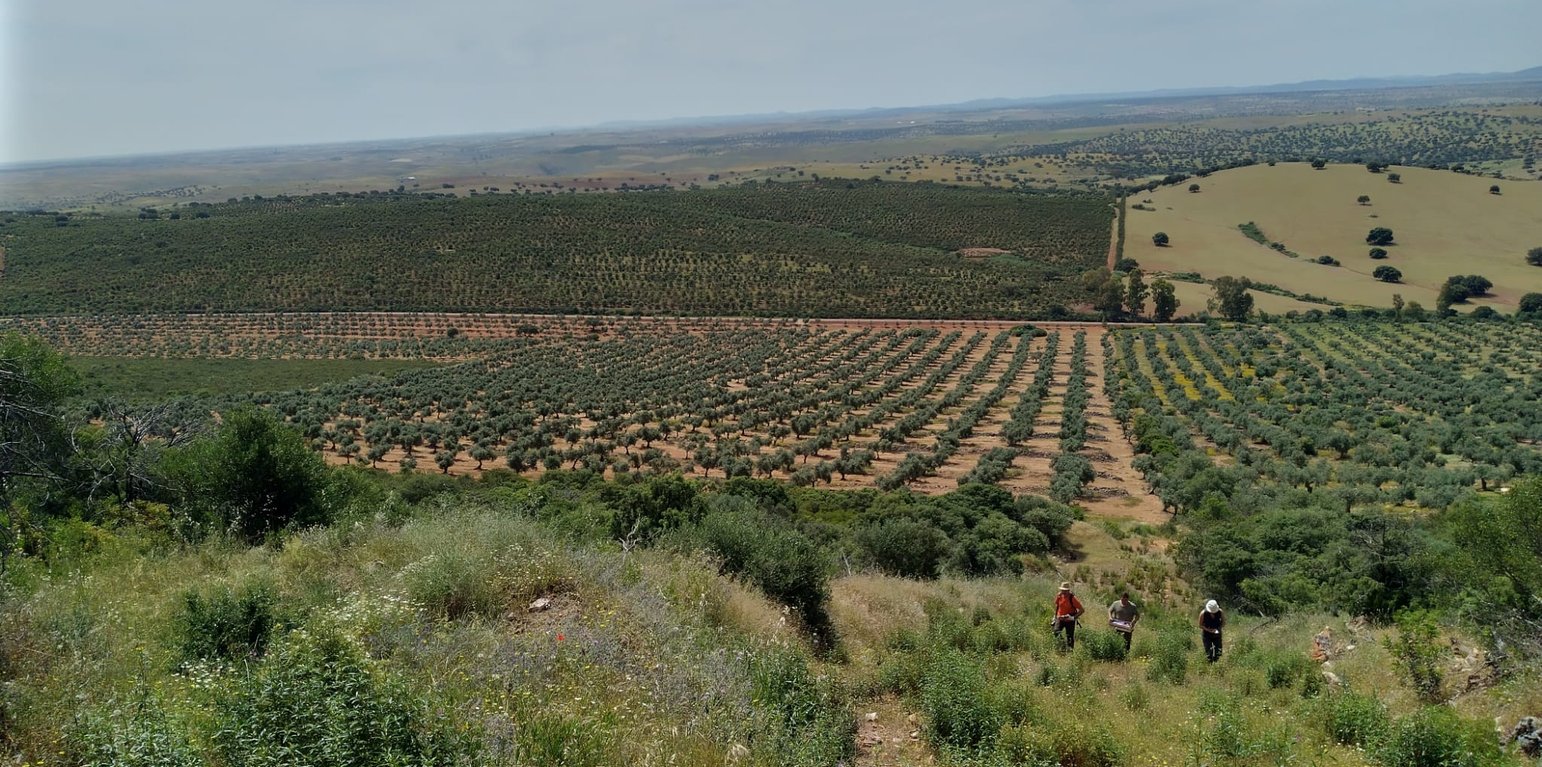Reforestation of degraded agricultural land.
(Espagne)
Programa de reforestación de tierras agrarias degradadas
Description
Degraded or abandoned agricultural land is under restoration in an area with a mediterranean climate, and a high risk of desertification. Plantations are based on indigenous forest species, mainly holm oak and cork oak, to ensure a sustainable mature forest in the future.
In Spanish, the "Program for Reforestation of Degraded Agricultural Lands" refers to the concept of "reforestación," which is typically translated into English as "afforestation." This can sometimes lead to translation issues. To ensure the term remains as close as possible to the original program's intent, the English term "reforestation" has been chosen.
Degraded or abandoned agricultural land is under restoration in rural areas in the West and South of the Iberian Peninsula. Here, there is a high risk and incidence of desertification. Reforestation – meaning restoring the original trees of the area - is a nature-based solution that contributes to the rehabilitation of degraded areas. The main objective is to reclaim land, mainly in rural environments, and to give it a second life capable of providing ecosystem and forest services.
Reforestation contributes to soil recovery, the increase of biodiversity associated with forest ecosystems, carbon sequestration and storage, the improvement of the landscape and the regulation of the hydrological cycle. Furthermore, in the arid areas of the West and South of the Iberian Peninsula, it provides a brake on the advance of desertification.
In order to carry out the reforestation, a technical reforestation project must be planned that includes species adapted to the environment which can accelerate the process of transforming the reforested area from a degraded area to a climax forest. Thus, plantations are based on indigenous forest species, mainly holm oak (Quercus ilex) and cork oak (Quercus suber), to ensure a sustainable mature forest in the future. The forest species, the planting framework, the soil preparation work, the design of the plantation, the planting season, the forest nursery from which the plants will be brought, and whether or not irrigation is required for planting are selected. It is necessary to design the maintenance work during the years after planting to ensure the long-term success of the reforestation.
It is important to have an adequate long-term reforestation plan that includes proper planting and maintenance in the subsequent years. This requires a sufficient budget to cope with the work, which includes forestry personnel and specialised machinery. In addition, the forest reproductive material used must come from nurseries where the origin of the plants is known and certified.
The advantages for land managers are many, mainly related to landscape and ecosystem restoration and erosion control. It can also provide landowners with added value in terms of an income based on livestock or forestry management, or in terms of carbon credits. As for the more negative aspects, it is a technology that requires economic investment and perseverance over the years, as it cannot be implemented quickly. Thus, most of the objectives are only fully achieved after several decades of effort and dedication.
Lieu
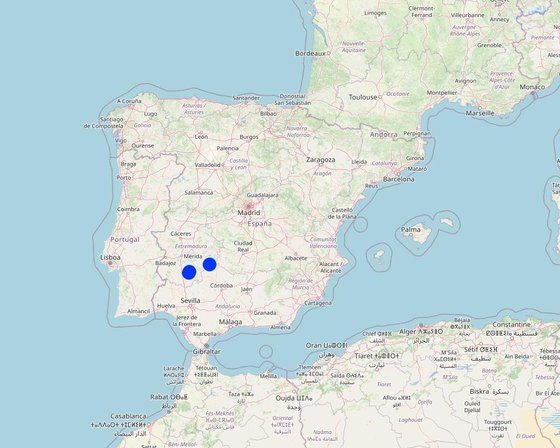
Lieu: Cabeza del Buey and Llera (Badajoz, Spain), Extremadura, Espagne
Nbr de sites de la Technologie analysés: 2-10 sites
Géo-référence des sites sélectionnés
-
-5.25805, 38.67755
-
-6.05425, 38.45547
-
-6.05975, 38.41753
Diffusion de la Technologie: répartie uniformément sur une zone (approx. 1-10 km2)
Dans des zones protégées en permanence ?: Non
Date de mise en oeuvre: 1996; il y a entre 10-50 ans
Type d'introduction
-
grâce à l'innovation d'exploitants des terres
-
dans le cadre d'un système traditionnel (> 50 ans)
-
au cours d'expérimentations / de recherches
-
par le biais de projets/ d'interventions extérieures
-
European subsidies
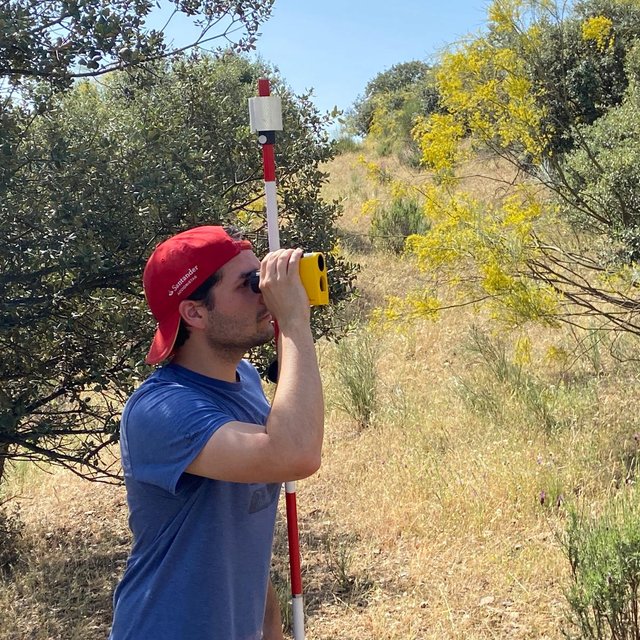
Measurement of trees in Quercus ilex and Quercus suber reforestation with in situ techniques to obtain biodiversity and carbon values. (Federico Julián)
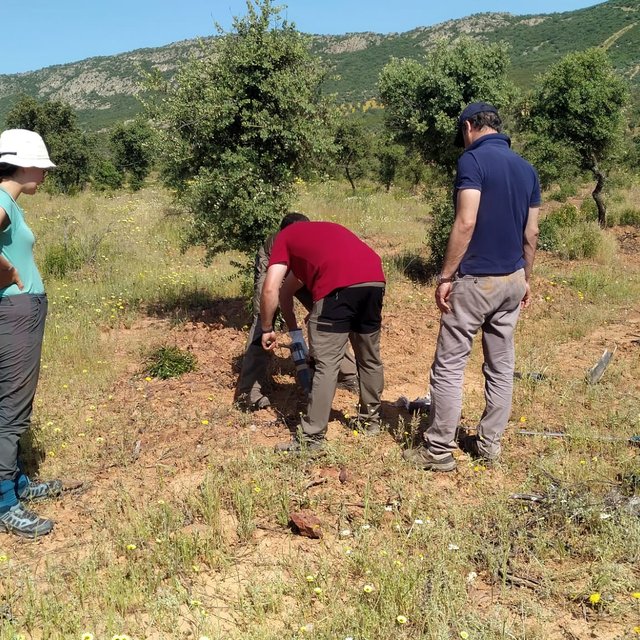
Soil sampling with in situ techniques to obtain biodiversity and carbon values at different depths. (Moritz Laub)
Classification de la Technologie
Principal objectif
-
améliorer la production
-
réduire, prévenir, restaurer les terres dégradées
-
préserver l'écosystème
-
protéger un bassin versant/ des zones situées en aval - en combinaison avec d'autres technologies
-
conserver/ améliorer la biodiversité
-
réduire les risques de catastrophes
-
s'adapter au changement et aux extrêmes climatiques et à leurs impacts
-
atténuer le changement climatique et ses impacts
-
créer un impact économique positif
-
créer un impact social positif
L'utilisation des terres
Les divers types d'utilisation des terres au sein du même unité de terrain: Oui - Agro-sylvo-pastoralisme
-
Forêts/ bois
- Plantations d'arbres, boisements. Variétés : Variétés mixtes
Tree types (forêts à feuillage persistant): sans objet
Produits et services: Bois de chauffage, Fruits et noix, Conservation/ protection de la nature
Approvisionnement en eau
-
pluvial
-
mixte: pluvial-irrigué
-
pleine irrigation
But relatif à la dégradation des terres
-
prévenir la dégradation des terres
-
réduire la dégradation des terres
-
restaurer/ réhabiliter des terres sévèrement dégradées
-
s'adapter à la dégradation des terres
-
non applicable
Dégradation des terres traité
-
érosion hydrique des sols - Wt: perte de la couche superficielle des sols (couche arable)/ érosion de surface
-
dégradation biologique - Bc: réduction de la couverture végétale, Bh: perte d’habitats, Bq: baisse de la quantité/ biomasse, Bs: baisse de la qualité et de la composition/ diversité des espèces, Bl: perte de la vie des sols
-
dégradation hydrique - Ha: aridification
Groupe de GDT
-
gestion des forêts naturelles et semi-naturelles
-
gestion des plantations forestières
-
agroforesterie
Mesures de GDT
-
pratiques végétales - V1: Couverture d’arbres et d’arbustes, V3: Défrichement de la végétation
-
modes de gestion - M1: Changement du type d’utilisation des terres
Dessin technique
Spécifications techniques
Soil preparation for planting.
Manual planting.
Tree planting. (Quercus ilex and Quercus suber)
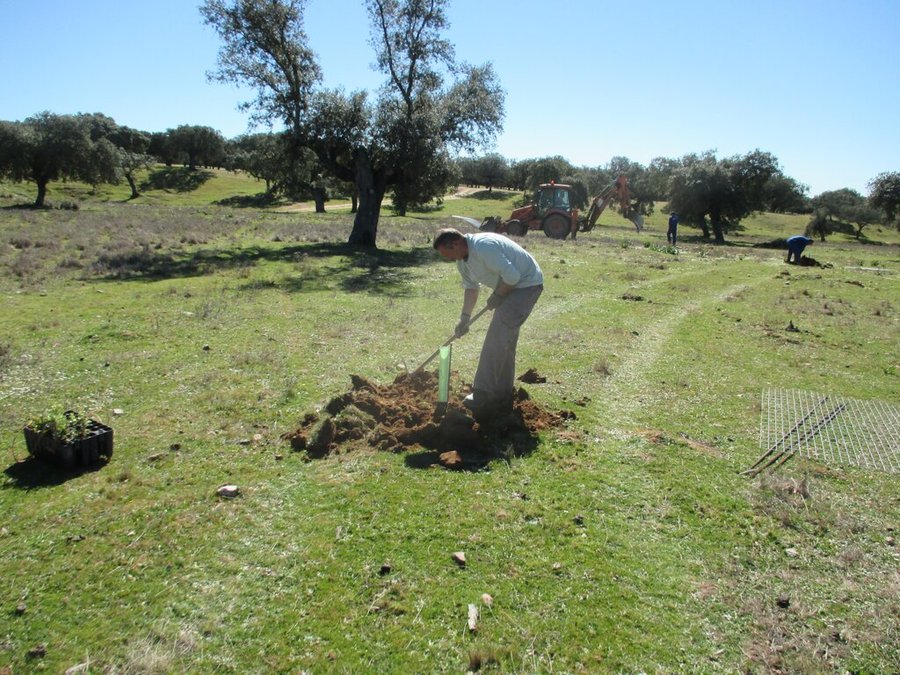
Author: José Ángel Rivas
Soil preparation for planting.
Manual and mechanised.
Tree planting.
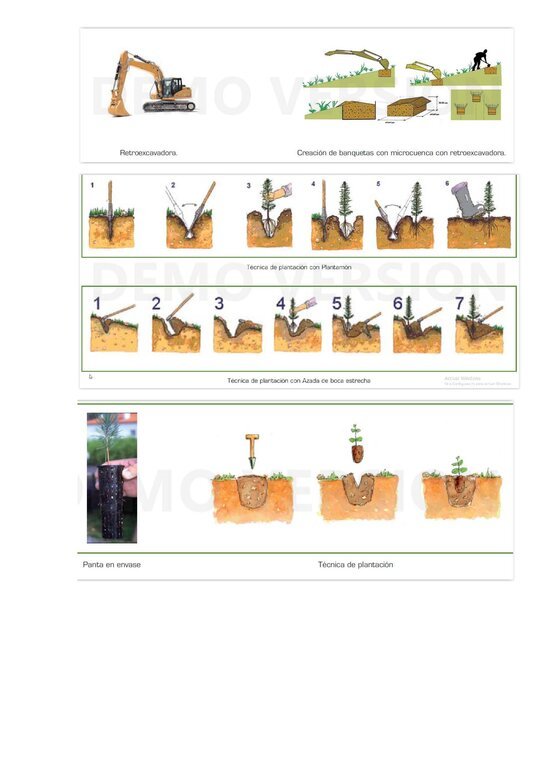
Author: Francisco Dorado, Álvaro garcía, Eugenio Caja del Castillo, Francisco Izquierdo, José Ignacio Rodríguez
Soil preparation for planting.
Manual planting.
Tree planting. (Quercus ilex and Quercus suber)
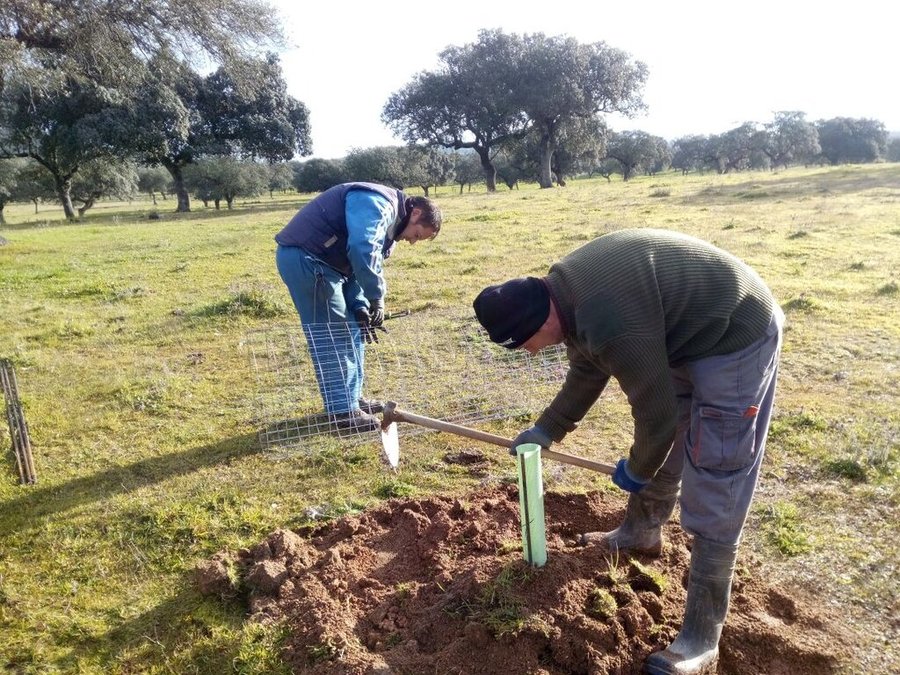
Author: José Ángel Rivas
Mise en œuvre et entretien : activités, intrants et coûts
Calcul des intrants et des coûts
- Les coûts sont calculés : par superficie de la Technologie (taille et unité de surface : 10-50 has; facteur de conversion pour un hectare : 1 ha = 3000 €/ha (reforestation) + 1000 €/ha (maintenance every 2 years))
- Monnaie utilisée pour le calcul des coûts : EUR
- Taux de change (en dollars américains - USD) : 1 USD = n.d. EUR
- Coût salarial moyen de la main-d'oeuvre par jour : 500 €/day
Facteurs les plus importants affectant les coûts
Working personnel and plant protection
Activités de mise en place/ d'établissement
-
Soil preparation for planting (Calendrier/ fréquence: Autumn-Winter)
-
Plants and seeds travel from nursery to farm (Calendrier/ fréquence: Winter)
-
Planting trees (Calendrier/ fréquence: Winter)
-
Protection for plants (Calendrier/ fréquence: Winter)
-
First irrigation for support plants (Calendrier/ fréquence: Spring- Summer)
-
Maintenance planting (Calendrier/ fréquence: Winter year 2-4-6-8-10)
Coût total de mise en place (estimation)
2999,0
Activités récurrentes d'entretien
n.a.
Coût total d'entretien (estimation)
3000,0
Environnement naturel
Précipitations annuelles
-
< 250 mm
-
251-500 mm
-
501-750 mm
-
751-1000 mm
-
1001-1500 mm
-
1501-2000 mm
-
2001-3000 mm
-
3001-4000 mm
-
> 4000 mm
Zones agro-climatiques
-
humide
-
subhumide
-
semi-aride
-
aride
Spécifications sur le climat
Précipitations moyennes annuelles en mm : 650.0
The Mediterranean climate is characterised by four months in summer with high temperatures and summer drought.
Nom de la station météorologique : Castuera (Badajoz, Spain)
The Mediterranean climate is a type of climate characterised by hot, dry summers and cold, rainy winters.
Pentes moyennes
-
plat (0-2 %)
-
faible (3-5%)
-
modéré (6-10%)
-
onduleux (11-15%)
-
vallonné (16-30%)
-
raide (31-60%)
-
très raide (>60%)
Reliefs
-
plateaux/ plaines
-
crêtes
-
flancs/ pentes de montagne
-
flancs/ pentes de colline
-
piémonts/ glacis (bas de pente)
-
fonds de vallée/bas-fonds
Zones altitudinales
-
0-100 m
-
101-500 m
-
501-1000 m
-
1001-1500 m
-
1501-2000 m
-
2001-2500 m
-
2501-3000 m
-
3001-4000 m
-
> 4000 m
La Technologie est appliquée dans
-
situations convexes
-
situations concaves
-
non pertinent
Profondeurs moyennes du sol
-
très superficiel (0-20 cm)
-
superficiel (21-50 cm)
-
modérément profond (51-80 cm)
-
profond (81-120 cm)
-
très profond (>120 cm)
Textures du sol (de la couche arable)
-
grossier/ léger (sablonneux)
-
moyen (limoneux)
-
fin/ lourd (argile)
Textures du sol (> 20 cm sous la surface)
-
grossier/ léger (sablonneux)
-
moyen (limoneux)
-
fin/ lourd (argile)
Matière organique de la couche arable
-
abondant (>3%)
-
moyen (1-3%)
-
faible (<1%)
Profondeur estimée de l’eau dans le sol
-
en surface
-
< 5 m
-
5-50 m
-
> 50 m
Disponibilité de l’eau de surface
-
excès
-
bonne
-
moyenne
-
faible/ absente
Qualité de l’eau (non traitée)
-
eau potable
-
faiblement potable (traitement nécessaire)
-
uniquement pour usage agricole (irrigation)
-
eau inutilisable
La qualité de l'eau fait référence à: eaux de surface
La salinité de l'eau est-elle un problème ?
Présence d'inondations
Caractéristiques des exploitants des terres appliquant la Technologie
Orientation du système de production
-
subsistance (auto-approvisionnement)
-
exploitation mixte (de subsistance/ commerciale)
-
commercial/ de marché
Revenus hors exploitation
-
moins de 10% de tous les revenus
-
10-50% de tous les revenus
-
> 50% de tous les revenus
Niveau relatif de richesse
-
très pauvre
-
pauvre
-
moyen
-
riche
-
très riche
Niveau de mécanisation
-
travail manuel
-
traction animale
-
mécanisé/ motorisé
Sédentaire ou nomade
-
Sédentaire
-
Semi-nomade
-
Nomade
Individus ou groupes
-
individu/ ménage
-
groupe/ communauté
-
coopérative
-
employé (entreprise, gouvernement)
Âge
-
enfants
-
jeunes
-
personnes d'âge moyen
-
personnes âgées
Superficie utilisée par ménage
-
< 0,5 ha
-
0,5-1 ha
-
1-2 ha
-
2-5 ha
-
5-15 ha
-
15-50 ha
-
50-100 ha
-
100-500 ha
-
500-1 000 ha
-
1 000-10 000 ha
-
> 10 000 ha
Échelle
-
petite dimension
-
moyenne dimension
-
grande dimension
Propriété foncière
-
état
-
entreprise
-
communauté/ village
-
groupe
-
individu, sans titre de propriété
-
individu, avec titre de propriété
Droits d’utilisation des terres
-
accès libre (non organisé)
-
communautaire (organisé)
-
loué
-
individuel
Droits d’utilisation de l’eau
-
accès libre (non organisé)
-
communautaire (organisé)
-
loué
-
individuel
Accès aux services et aux infrastructures
emploi (par ex. hors exploitation)
eau potable et assainissement
Impact
Impacts socio-économiques
qualité des forêts/ bois
en baisse
en augmentation
Quantité avant la GDT: Agricultural degraded area
Quantité après la GDT: Climatic Mediterranean Forest growing
gestion des terres
Quantité avant la GDT: Agricultural degraded and abandoned area
Quantité après la GDT: Climatic Mediterranean Forest growing
Impacts socioculturels
connaissances sur la GDT/ dégradation des terres
Quantité avant la GDT: Agricultural degraded and abandoned area
Quantité après la GDT: Climatic Mediterranean Forest growing
Learning about reforestation maintenance over three decades
Impacts écologiques
couverture du sol
Quantité avant la GDT: Agricultural degraded and abandoned area
Quantité après la GDT: Climatic Mediterranean Forest growing
Soil samples taken show an increase in organic matter and C fixed in the soil.
matière organique du sol/ au dessous du sol C
en baisse
en augmentation
Quantité avant la GDT: Agricultural degraded and abandoned area
Quantité après la GDT: Climatic Mediterranean Forest growing
Soil samples taken show an increase in organic matter and C fixed in the soil.
biomasse/ au dessus du sol C
en baisse
en augmentation
Quantité avant la GDT: Agricultural degraded and abandoned area
Quantité après la GDT: Climatic Mediterranean Forest growing
No trees existed prior to planting.
diversité végétale
en baisse
en augmentation
Quantité avant la GDT: Agricultural degraded and abandoned area
Quantité après la GDT: Climatic Mediterranean Forest growing
Quercus ilex, Quercus suber, and more than 15 Mediterranean species monitored
diversité des habitats
en baisse
en augmentation
Quantité avant la GDT: Agricultural degraded and abandoned area
Quantité après la GDT: Climatic Mediterranean Forest growing
A new Mediterranean ecosystem growing towards a forest of climatic quality capable of supporting fauna and flora.
impacts de la sécheresse
en augmentation
en baisse
Quantité avant la GDT: Agricultural degraded and abandoned area
Quantité après la GDT: Climatic Mediterranean Forest growing
The reforested area represents a brake on the advance of desertification in the area.
émissions de carbone et de gaz à effet de serre
en augmentation
en baisse
Quantité avant la GDT: Agricultural degraded and abandoned area
Quantité après la GDT: Climatic Mediterranean Forest growing
Although the soils in the area are poor and difficult to store carbon, the first sampling data give positive values for the soil. In terms of forest biomass the increase is total over a baseline of zero.
Impacts hors site
pollution des rivières/ nappes phréatiques
capacité tampon/de filtration (par les sols, la végétation, les zones humides)
impact des gaz à effet de serre
Quantité avant la GDT: Agricultural degraded and abandoned area
Quantité après la GDT: Climatic Mediterranean Forest growing
It is considered a land mitigation technology because of its ability to sequester and store carbon in soil and biomass.
Analyse coûts-bénéfices
Bénéfices par rapport aux coûts de mise en place
Rentabilité à court terme
très négative
très positive
Rentabilité à long terme
très négative
très positive
Bénéfices par rapport aux coûts d'entretien
Rentabilité à court terme
très négative
très positive
Rentabilité à long terme
très négative
très positive
Changement climatique
Changements climatiques progressifs
Microclimate high temperature décroît
pas bien du tout
très bien
Extrêmes climatiques (catastrophes)
Fight against desertification
pas bien du tout
très bien
Adoption et adaptation de la Technologie
Pourcentage d'exploitants des terres ayant adopté la Technologie dans la région
-
cas isolés/ expérimentaux
-
1-10%
-
11-50%
-
> 50%
Parmi tous ceux qui ont adopté la Technologie, combien d'entre eux l'ont fait spontanément, à savoir sans recevoir aucune incitation matérielle ou aucun paiement ?
-
0-10%
-
11-50%
-
51-90%
-
91-100%
La Technologie a-t-elle été récemment modifiée pour s'adapter à l'évolution des conditions ?
A quel changement ?
-
changements/ extrêmes climatiques
-
évolution des marchés
-
la disponibilité de la main-d'œuvre (par ex., en raison de migrations)
Drought forces the design of plantations with greater technical restrictions for species adaptation and greater water retention capacity.
Conclusions et enseignements tirés
Points forts: point de vue de l'exploitant des terres
Points forts: point de vue du compilateur ou d'une autre personne-ressource clé
Faiblesses/ inconvénients/ risques: point de vue de l'exploitant des terrescomment surmonter
Faiblesses/ inconvénients/ risques: point de vue du compilateur ou d'une autre personne-ressource clécomment surmonter
Références
Examinateur
-
William Critchley
-
Rima Mekdaschi Studer
Date de mise en oeuvre: 23 avril 2024
Dernière mise à jour: 11 décembre 2024
Personnes-ressources
-
Federico Julian - Spécialiste GDT
Description complète dans la base de données WOCAT
Données de GDT correspondantes
La documentation a été facilitée par
Institution
- AMBIENTA Ingeniería y Servicios Agrarios y Forestales S.L. (AMBIENTA) - Espagne
Projet
- Land Use Based Mitigation for Resilient Climate Pathways (LANDMARC)
Références clés
-
Initial soil carbon losses may offset decades of biomass carbon accumulation in Mediterranean afforestation. 2023. Valeria Renna, Pilar Martín-Gallego, Federico Julián, Johan Six , R´emi Cardinael, Moritz Laub: Geoderma Regional 36 (2024) e00768 Online - free
-
Programa de forestación de tierras agrarias en Andalucía. Jiménez, Navarro, 2014.: Online - free
-
Repoblación forestal. Forestación de tierras agrícolas. Castilla la Mancha. Francisco Dorado, Álvaro garcía, Eugenio Caja del Castillo, Francisco Izquierdo, José Ignacio Rodríguez: Online - free
-
La forestación de tierras agrarias a través de los Programas de Desarrollo Rural en España: Una medida con impacto medioambiental positivo en el medio rural. Miguel Angel Fernández Carrillo. Belmonte Serrato F. Romero Díaz A. Francisco Robledano: Online - free
Liens vers des informations pertinentes disponibles en ligne
